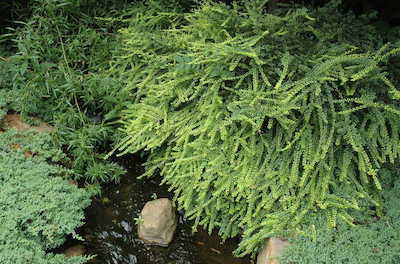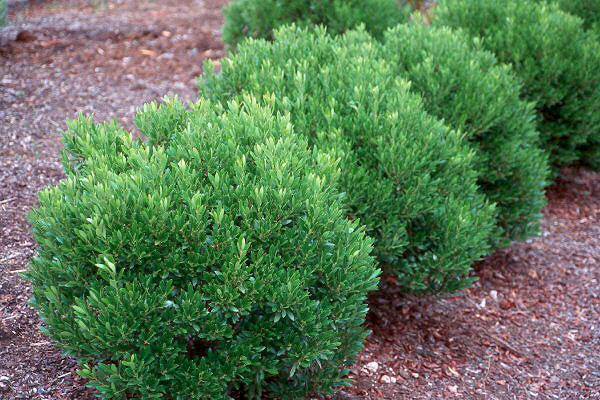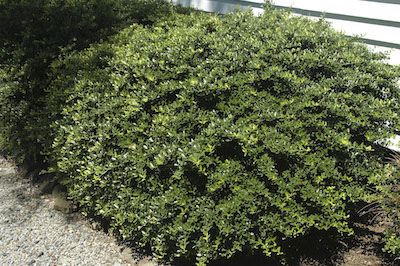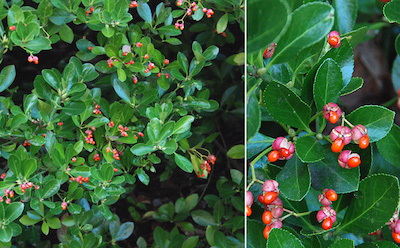Alternatives to Boxwood
By Mary David, Fairfax Master Gardener
History of Boxwood Blight

Boxwood blight
In 2011, the boxwood landscape changed quite literally when a fungal pathogen, Cylindrocladium pseudonaviculatum, was discovered in North Carolina and Connecticut. The sticky spores of the fungus adhered to birds, animals, pruning tools, shoes, clothing and leaf litter, giving the pathogen many ways to spread to new locations. By 2019, more than 20 states, including Virginia, and three Canadian provinces have documented the presence of C. pseudonaviculatum or boxwood blight.
There is no cure for heavily infected plants. At this point, and until researchers have boxwood blight figured out, it makes sense to consider planting shrubs with the small evergreen leaves and dense branching similar to boxwood rather than the real thing.
Alternative Shrubs to Consider
Lonicera nitida (Boxleaf honeysuckle)
I spotted my first boxwood lookalike from a distance while visiting Green Spring Gardens. The shrub’s dark green color and small leaves seemed dead-on for Buxus sempervirens. But something wasn’t quite right. As I got closer, I could see the shrub was more graceful than any boxwood I had seen. The branches were slightly arching and layered over each other. I read the name tag. Lonicera nitida. Lonicera? Honeysuckle? Yes, boxleaf honeysuckle.

Lonicera nitida ‘Baggesen’s Gold’
The shrub is hardy in zones 6-9, reaching a height of 6 to 8 feet and width of 4 to 7 feet. If that seems a little too large for your space, boxleaf honeysuckle loves to be pruned back, making it the perfect plant for hedges and topiaries. It is even popular with bonsai gardeners. Small, tubular flowers appear in pairs, creamy white and hidden in the leaves, from May to June. Pea-sized, bluish-purple berries mature in the fall — not plentiful, but beloved by birds. There are other praises to sing, such as the shrub is deer resistant, attracts pollinating insects, tolerates pollution and salt spray, is unattractive to rabbits and makes a great cover for birds. Plus, there are no serious disease or pest problems.
The shrub’s leaves are a glossy dark green, simple, egg-shaped and no more than 16 mm long — half the size of its namesake boxwood. They are arranged in flat, opposite pairs along supple stems, which send out horizontal secondary twigs on both sides. The branches are layered one on top of the other, giving the shrub a lacy, delicate appearance that belies its hardiness.
Boxleaf honeysuckle has several variegated and gold-toned cultivars. Look for ‘Lemon Beauty,’ ‘Silver Beauty,’ ‘Red Tips,’ ‘Briliame,’ ‘Briloni,’ ‘Maigrün’ and the stunning ‘Baggesen’s Gold.’
Ilex glabra (Inkberry Holly)
Hardy in zones 5-9, inkberry holly is an easily grown upright, broadleaf evergreen shrub, native to the coastal plain of eastern North America. Its height is 4 to 6 feet and its width 4 to 5 feet. It grows best in full sun but has good shade tolerance. It prefers consistently moist, well-drained, acid soil but adapts well to most average soil conditions.

Ilex glabra ‘Shamrock’
Inconspicuous tiny white flowers in late spring yield abundant jet-black berries in the fall. Inkberries are dioecious — female plants need a male plant for pollination in order to produce fruit. Inkberries spread by root suckers to form colonies. Be prepared to prune these if this kind of expansion is not what you want. There are no serious disease or pest problems. (Rutgers Deer Resistance Rating: B seldom severely damaged).
There are a number of I. glabra cultivars to choose from. Here are three to consider:
‘Shamrock’ is a compact, rounded cultivar that slowly reaches 3 to 4 feet in height and suckers less than the species. Has a dense twiggy habit. Can be selectively pruned but not sheared. Tolerates moist to wet soils making it a good choice for locations near a pond or other wet areas of the yard. Also, outstanding for shrub borders. Easy care, slow growing.
‘Gem Box’® was introduced in 2016 as an “excellent alternative to boxwood.” Extremely dense, globe-shaped plant with good branching all the way down to the ground, avoiding the bare-legged look typical of the species. Height and width 2 to 3 feet. Small, dainty dark green foliage often shows reddish-burgundy tips during the spring flush. Makes a great container specimen. Easy care, slow growing.
‘Strongbox’® arrived in the market in 2018. Height and width also 2 to 3 feet. Leaves are a little larger and shape is more mounded and squat than Gem Box®. The foliage is thick and dense even on the lower branches. Good as a low hedge or edging. Easy care, slow growing.
Ilex crenata (Japanese Holly)
Hardy in zones 5-8, Japanese holly has a height of 10 to 12 feet and a width of 5 to 8 feet. Most cultivars are considerably smaller, approximately 3 to 4 feet. It prefers full sun to part shade and light, moist, acidic soil with good drainage. It will tolerate a wide variety of soils from moist to dry and from sand to clay. It will develop iron deficiency if pH is too high and may struggle with heat and humidity in the deep South (zones 8-9).

ilex crenata
Euonymus japonicus (Japanese Euonymus, Japanese Spindle Tree)
Hardy in zones 6-9, Japanese Euonymus or Spindle Tree is a very dense, broadleaf evergreen shrub growing 10 to 15 feet high and 5 to 8 feet wide. It handles full sun to heavy shade but grows best in dappled-shade. It is tolerant of a variety of conditions, including heat, poor soils and salt spray.
Its shiny dark green leaves are opposite, simple, leathery and narrowly oval with finely serrated margins, except at the base. Leaves are 1 to 3 inches in length and can be heavily pruned. {Rutgers Deer Resistance Scale = C: occasionally severely damaged).

Euonymus japonicus
‘Greenspire’ is a multi-stemmed evergreen shrub with a narrow, upright, columnar growth habit. Height 6 to 8 feet, width 1 to 2 feet. Glossy, green foliage makes great clipped hedges that require minimal pruning for a formal appearance. Can be pruned anytime. Its naturally narrow growth habit is ideal for small properties; excellent for hedging and border applications. Easy care, fast growing.
‘Microphyllus,’ or boxleaf euonymus, is a dwarf evergreen shrub. Height 1 to 2 feet and nearly as wide. Deep green, dense foliage on a compact plant provides a beautiful formal appearance with minimal trimming. An excellent container specimen, easily sheared into mini cones or spheres. Perfect for low hedge or border. Easy care, slow growing.
Juke Box® x Pyracomeles (Pyracantha x Osteomeles)
Introduced as a boxwood alternative in the spring of 2019 by Proven Winners, Juke Box is an intergeneric cross between Pyracantha and Osteomeles, without the thorns or flowers of its parents. Hardy in zones 7-9, it grows 1 to 3 feet tall and wide. It grows in full sun to light shade, is heat tolerant and needs average soil and water. Juke Box is a tightly branched, compact, broadleaf evergreen with a natural globe-like habit and shiny, bright green foliage. It can be easily shaped as a hedge, border or topiary. It is a good foundation plant with easy care.
References
Landscape Plants: Lonicera nitida, Oregon State University, Department of Horticulture
Lonicera nitida ‘Twiggy’, Missouri Botanical Garden
Selecting Landscape Plants: Boxwoods, VCE Publication 426-603 (HORT-290P)
Boxwood Blight: A New Disease of Boxwood Found in the Eastern U.S., VCE Publication PPWS-4
Boxwood Blight, Purdue Extension Publication BP-203-W
Lonicera nitida, Missouri Botanical Garden
Landscape Plants: Euonymus japonicus, Oregon State University, Department of Horticulture
Euonymus japonicus, Missouri Botanical Garden